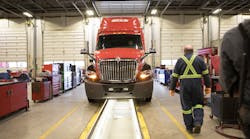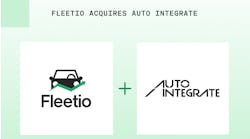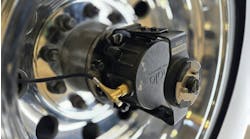With all of the data and information collected on today’s vehicles and within a fleet’s operations, calculating the total cost of ownership (TCO) for fleet assets is one method for utilizing this data and creating actionable ways to improve the performance and optimization of the fleet.
Understanding the TCO of a vehicle or trailer can provide an objective view of the full expense to purchase and operate that asset. To state the obvious, a lower TCO is better for the fleet.
In order to calculate an asset’s TCO, a fleet must first collect the necessary data and set up parameters with which to measure useful life of that asset. To do this, fleets must establish different categories under which their organization will benchmark expenses – known as key performance indicators (KPIs) – and observe trends in data collected.
What data to review and assess
There is no silver bullet to determine the best time to cycle out old vehicles. There are, however, best practices to consider when working toward understanding the total cost of vehicle ownership, and the optimal time for vehicle replacement. There are numerous factors to consider based on fleet size, fleet type, vehicle type, geographic location, etc.
Jim Nachtman, heavy duty marketing director for Navistar – original equipment manufacturer for International brand trucks – advises that fleets can evaluate TCO calculations on the following criteria: purchase cost of the asset; fueling expenses (which include diesel exhaust fluid); planned maintenance; and uptime. Maintenance refers to any planned or scheduled events for the asset. Uptime would include any unexpected expenses such as breakdowns, accidents, towing, etc. He says some fleets may include driver expenses in their TCO calculations as well.
These criteria – and many more – are measured through established KPIs, which allow fleets to set benchmarks and review the data to implement changes and improvements to their operation. Fleets can set KPIs based on employees – both technicians and drivers – as well as the assets themselves.
For instance, a fleet may measure the performance of miles per gallon average on a weekly or monthly basis achieved by each driver, or the actual time versus standard repair time established for specific repairs completed by technicians.
When it comes to asset KPIs and data counts, there are numerous options to monitor and track, including (but not limited to):
- Cost per mile for fuel
- Cost per mile for maintenance
- Overall miles per gallon
- Fuel costs
- Emissions information and idle times
- Hours vehicle is operated
- Tire costs
- Maintenance and repair costs by VMRS
- Maintenance and repair costs by vehicle model year
- Maintenance and repair costs by specified components
As the saying goes, bad data is worse than no data. It is critical that fleets work to have a clear, standard process that all employees adhere to in order to collect accurate information.
One way to validate standardized information is to categorize information through VMRS codes, or other established coding structures. VMRS stands for Vehicle Maintenance Reporting Standards.
“All of this information is collected from repair orders, trip reports, and fuel transaction reports,” says Jarit Cornelius, vice president, asset maintenance and compliance for Sharp Transport. “We put a lot of attention on accurate data input. Otherwise, these reports would be skewed and meaningless.”
Founded in 1979, Sharp Transport is a family-owned truckload carrier based in Middle Tennessee, operating dry van, flatbed, heavy haul, end dumps, and dedicated contract services.
Other sources where fleets can collect data include electronic logging devices, or ELDs, and the on-board computer of the vehicle, says Brian Holland, president and CFO of Fleet Advantage.
Fleet Advantage serves fleets as a specialty finance and leasing company and business intelligence and asset management firm for the commercial vehicle market.
Southeastern Freight Lines designates internal “fleet codes” for different vehicle groups, according to Lee Long, director of fleet services for Southeastern Freight Lines. “What this means is that we may purchase multiple OE units and each one in that purchase group has the same specifications. The next group may have other items not included in the first group.”
Southeastern Freight Lines is a privately held less-than-truckload (LTL) carrier operating in 14 southeastern states and Puerto Rico, in 90 strategic locations. Employing more than 8,000 individuals, the company operates 26 maintenance facilities with 400 technicians.
“When it comes to a fleet testing [new vehicle] technologies themselves, it is best to have a large number of vehicles operated in the same way, but with limited differences between the vehicles,” Nachtman says. “For example, if a fleet bought 100 trucks, half with one component and half with another component, they could evaluate the TCO impact.”
Long cites a specific example from a recent specification within the Southeastern Freight Lines fleet; one group of purchased tractors were specified with an automated manual transmission, while the other vehicles were specified with fully automatic transmissions.
“With these [groups] having unique fleet codes assigned to them, we can evaluate the cost-effectiveness of several key components: miles-per-gallon, repair costs overall, and component repair costs," he says. "This is valuable when testing new technology.”
“For components offered in different variations and/or from different vendors, it is important to evaluate tradeoffs,” Nachtman adds. One relatable example for all fleets is tire specification and weighing the benefits and drawbacks to features such as tread depth, durability, and rolling resistance. “That tradeoff should be evaluated to best suit the application and business goals of the customer. Some technologies reduce weight or increase fuel efficiency but may reduce residual value. That tradeoff should be evaluated.”
Process of evaluation
“Fleets can record and evaluate TCO data using simple spreadsheets, all the way up to advanced proprietary software developed by the fleets themselves,” says Navistar’s Nachtman. “All expenses must be recorded over the life of the vehicle to provide a true TCO view.”
Penske Truck Leasing has a comprehensive program established to evaluate TCO. Penske uses a proprietary, internally built system to collect and evaluate this information.
Based in Reading, Pennsylvania, Penske Truck Leasing provides full-service commercial truck leasing, truck fleet contract maintenance, truck rentals, and used truck sales.
Paul Rosa, senior vice president of procurement and fleet planning for Penske Truck Leasing, explains that the process begins at a high level. Data on operational costs is obtained through numerous variables, including application, cost per mile, uptime in relation to how long the vehicle has been with the fleet, and vehicle component performance, such as braking systems, liftgates, engines, etc.
From there, Rosa says Penske will review groups that have similar functions or properties and compare one variable.
“We then get into metrics on the performance by OEM, the performance by a model from an OEM and then we compare that,” Rosa says. “Now you get into brand A's tractor versus brand B's tractor in a similar application, going a certain number of miles; you start to have a lot of comparative data that you can … [collect] over many, many years. You can really develop a model that helps [to guide you] in your TCO decisions.”
In other words, to figure out the full TCO, Penske evaluates the lifecycle of different systems or components, dependent on their application, and can make decisions based on the performance of vehicles with those certain systems.
“[If] you're determining your useful life at that high level versus realizing there's a component that's causing you to have to shorten the life of that whole asset, and if you were to improve one part or multiple parts [of the vehicle specification], that could give you [increased] longevity of the asset,” Rosa explains.
Additionally, because of their relationships with OEs, according to Rosa, Penske is able to share insights on the performance of these different vehicle systems to allow the vehicle manufacturers to make improvements upon the design of their products.
These benefits are also transferred to the lease customer.
“It allows a lease customer, instead of going only five years because they'd do a hundred thousand miles, well now maybe they go six years because the vehicle can now last longer,” Rosa explains.
Fleet Advantage provides an asset management solution which combines leasing options and comprehensive vehicle performance monitoring. The company offers flexible leasing options through its ExchangeIT program. Fleets who participate in this program also have access to Fleet Advantage’s software product called Advanced Truck Lifecycle Administrative Analytics Software, or ATLAAS. An interface provides fleets the ability to monitor and manage their total cost of ownership, Holland says.
“Factors such as monthly payment, interest, depreciation, the cost of fuel, utilization, and maintenance and repair, are all factored into an algorithm,” Holland says. “Fleet Advantage monitors the fleet by individual vehicle and groups of vehicles to determine the most cost-effective lifecycle and fleet optimization plan.”
Fleet Advantage will provide an assessment for fleet customers to provide individual benchmarks, but also industry benchmarks based on anonymous data from other FA users. Currently, they provide these assessments for leased vehicles, financed through Fleet Advantage.
“What we provide to a client is their information, but we can also provide to them benchmarking data on a no-names basis from other fleets," Holland says. "So not only can they benchmark against themselves, but they can benchmark against others in the industry.”
The case for shorter vehicle lifecycles
The outcome of the collection and assessment of data can help fleets determine when to cycle out old equipment. A tipping point, or threshold, can be set to determine the cost of a replacement versus the repair of an asset. Southeastern Freight Lines will set periodic mileage or vehicle age evaluations to do this.
“For instance, if a unit hits 750,000 [miles], we are going to do an evaluation on the unit to determine what costs have been incurred and if it is feasible to install a new engine, transmission, etc. into that unit,” Long advises.
“Data is being leveraged by fleets today not only to help with predictive maintenance, but also to determine when it costs more to maintain a truck as opposed to replacing with a newer unit,” explains Fleet Advantage’s Holland. “There are many different areas fleets can focus on when it comes to increasing reliability and lowering maintenance costs when evaluating lifecycle strategies, but preventive maintenance is crucial. The more money fleets spend on predictive maintenance, the lower their overall maintenance costs will be.”
Holland provides details on a real-world comparison between a relatively old tractor and a new unit, as it relates to maintenance costs.
“Data helped uncover the costs associated with maintenance and repair on an older truck versus those costs associated with a first-year truck,” he explains. “When analyzing operating costs for a Class 8 heavy duty truck on an annual basis, the maintenance and repair cost of a 2012 model-year sleeper is $23,100. However, maintenance and repair costs on a 2019 model-year unit first year in service are just $2,070, a savings of approximately $21,030.”
It is important to note that further evaluation is required, to consider additional factors such as upfront purchase cost or leasing terms and finance rates, insurance costs, and fueling costs.
“The [Southeastern Freight Lines] Fleet Services Department is always searching for methods and products to minimize the maintenance cost that is incurred during the life of our equipment,” adds Long. He provides an example of extending the preventive maintenance (PM) schedule of the company’s trailers from five to seven years.
“With the improvements in lubricants, wheel end manufacturer’s warranties, and using disc brakes on these units, we changed our process to every seven years to do this work," he says. "With keeping these units in the fleet for 20-plus years, we reduced the major PM process by one event and lowered our overall costs. This calculates to great cost savings due to having 9,000-plus trailers in the fleet.”
In addition to an evaluation of maintenance and repair spending, the latest vehicle technology developments have allowed fleets to consider shortening vehicle lifecycles.
“As fuel economy improves year-over-year, uptime improves with each model year in general, safety systems become more advanced, and driver features expand, it becomes more important for fleets to replace older vehicles with the latest technologies,” says Navistar’s Nachtman. “Higher asset utilization at many fleets is allowing fleets to accumulate their desired mileage to trade in, at an earlier time. In many cases, fleets are evaluating shorter trade cycles, both mileage and time-based.”
Holland says Fleet Advantage customers have shortened the lifecycle of power units down between three and four years, compared to the previous seven to 10-year cycle.
“Until recently, a large part of the industry believed in longer lifecycles,” Holland says. “This was based on the longevity of the truck. Yes, the truck will run one million miles, but at what cost? Now that we have access to the full data set and are able to calculate the TCO with high accuracy, we know the ideal lifecycle in most applications ranges between 350,000 and 400,000 miles.”
Cycling out old units
When setting up the cycling out process to remove old vehicles and obtain new ones in the fleet, it’s important that all departments work together and communicate the changes. This can include any number of departments including accounting, management, maintenance, and legal teams.
The actual process is on-going, advises Penske’s Rosa.
“It's a year-round process, meaning a year in advance,” he says. “If you're a customer of ours who's leasing the vehicle and it's on a six-year term and it's the end of your fifth year – depending upon the lead time for the replacement unit – you could be starting even sooner than that or you have a little window on it where you have to work things out.”
For financing of leased or purchased vehicles, interest rates can also play a role in the timing of the cycling out process.
“If you know there's impending interest rate increases from the federal government, they may be pulling that decision up sooner," Rosa adds. "If you know there are reductions that are on the horizon, you may be pushing it out farther.”
Takeaways
“We have determined that there's a lot of different ways that fleets can improve their productivity, improve efficiency, and lower cost," says Fleet Advantage's Holland. "But the single most impactful practice is managing the lifecycle of the asset.”
TCO works on a cycle and requires constant research to understand industry trends and evaluate what would work best for the next purchase.
This process takes buy-in and communication among multiple departments and involves an evaluation of full asset expenses – including upfront purchase or lease costs, fueling costs, and maintenance spending.




